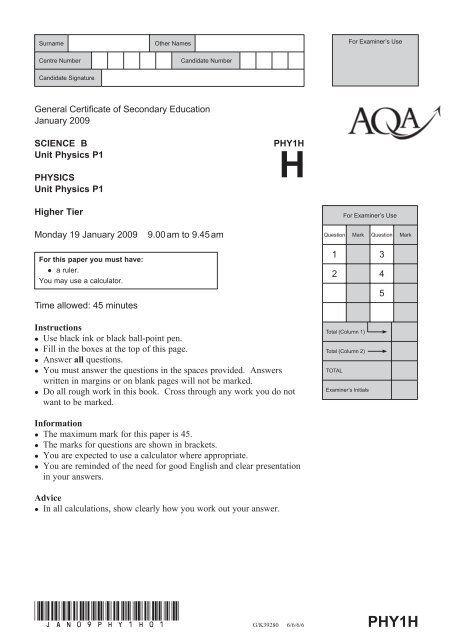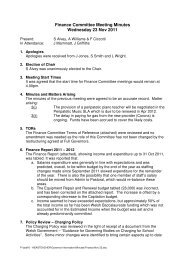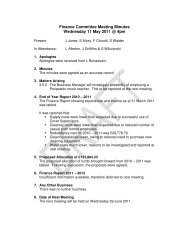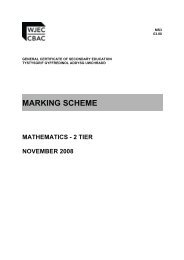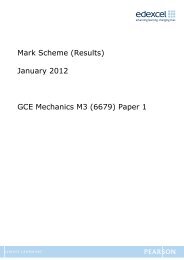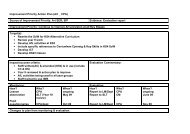GCSE Science B (Physics) Unit 1 Physics (Higher ... - Physics@egs
GCSE Science B (Physics) Unit 1 Physics (Higher ... - Physics@egs
GCSE Science B (Physics) Unit 1 Physics (Higher ... - Physics@egs
Create successful ePaper yourself
Turn your PDF publications into a flip-book with our unique Google optimized e-Paper software.
Surname<br />
Other Names<br />
For Examiner’s Use<br />
Centre Number<br />
Candidate Number<br />
Candidate Signature<br />
General Certifi cate of Secondary Education<br />
January 2009<br />
SCIENCE B<br />
<strong>Unit</strong> <strong>Physics</strong> P1<br />
PHYSICS<br />
<strong>Unit</strong> <strong>Physics</strong> P1<br />
PHY1H<br />
H<br />
<strong>Higher</strong> Tier<br />
Monday 19 January 2009<br />
For this paper you must have:<br />
• a ruler.<br />
You may use a calculator.<br />
Time allowed: 45 minutes<br />
9.00 am to 9.45 am<br />
For Examiner’s Use<br />
Question Mark Question Mark<br />
1 3<br />
2 4<br />
5<br />
Instructions<br />
• Use black ink or black ball-point pen.<br />
• Fill in the boxes at the top of this page.<br />
• Answer all questions.<br />
• You must answer the questions in the spaces provided. Answers<br />
written in margins or on blank pages will not be marked.<br />
• Do all rough work in this book. Cross through any work you do not<br />
want to be marked.<br />
Total (Column 1)<br />
Total (Column 2)<br />
TOTAL<br />
Examiner’s Initials<br />
Information<br />
• The maximum mark for this paper is 45.<br />
• The marks for questions are shown in brackets.<br />
• You are expected to use a calculator where appropriate.<br />
• You are reminded of the need for good English and clear presentation<br />
in your answers.<br />
Advice<br />
• In all calculations, show clearly how you work out your answer.<br />
(JAN09PHY1H01)<br />
G/K39280 6/6/6/6<br />
PHY1H
2<br />
Areas outside<br />
the box will<br />
not be scanned<br />
for marking<br />
Answer all questions in the spaces provided.<br />
1 A vacuum flask is designed to reduce the rate of heat transfer.<br />
Plastic cap<br />
Silvered<br />
surfaces<br />
Vacuum<br />
1 (a) (i) Complete the table to show which methods of heat transfer are reduced by each<br />
of the features labelled in the diagram.<br />
The first row has been done for you.<br />
Feature Conduction Convection Radiation<br />
vacuum <br />
silvered surfaces<br />
plastic cap<br />
(2 marks)<br />
1 (a) (ii) Explain why the vacuum between the glass walls of the flask reduces heat<br />
transfer by conduction and convection.<br />
...................................................................................................................................<br />
...................................................................................................................................<br />
...................................................................................................................................<br />
...................................................................................................................................<br />
(2 marks)<br />
(02)<br />
G/K39280/Jan09/PHY1H
3<br />
Areas outside<br />
the box will<br />
not be scanned<br />
for marking<br />
1 (b) The diagram shows a gas flame patio heater.<br />
Top surface of<br />
the reflecting hood<br />
Gas flames<br />
Gas bottle<br />
1 (b) (i) Explain why the top surface of the reflecting hood should be a light, shiny<br />
surface rather than a dark, matt surface.<br />
...................................................................................................................................<br />
...................................................................................................................................<br />
...................................................................................................................................<br />
(2 marks)<br />
1 (b) (ii) Most of the chemical energy in the gas is transformed into heat. A small amount<br />
of chemical energy is transformed into light.<br />
Draw and label a Sankey diagram for the patio heater.<br />
(2 marks)<br />
1 (b) (iii) State why the total energy supplied to the patio heater must always equal the total<br />
energy transferred by the patio heater.<br />
...................................................................................................................................<br />
...................................................................................................................................<br />
(1 mark) 9<br />
Turn over <br />
(03)<br />
G/K39280/Jan09/PHY1H
4<br />
Areas outside<br />
the box will<br />
not be scanned<br />
for marking<br />
2 The pictures show three different types of electric heater.<br />
400 W oil-filled panel heater<br />
(wall mounted)<br />
3 heat settings<br />
Efficient background heat<br />
Safety overheat cut-out<br />
3 kW fan heater<br />
2 heat settings<br />
Power indicator light<br />
Cool air fan setting<br />
1800 W ceramic heater<br />
2 heat settings<br />
8 hour timer<br />
Power indicator light<br />
Safety overheat cut-out<br />
2 (a) The ceramic heater is run on full power for 5 hours.<br />
Use the following equation to calculate, in kilowatt-hours, the amount of energy<br />
transferred from the mains to the heater.<br />
energy transferred = power × time<br />
Show clearly how you work out your answer.<br />
.............................................................................................................................................<br />
.............................................................................................................................................<br />
Energy transferred = .............................. kilowatt-hours<br />
(2 marks)<br />
2 (b) Which heater will be the most expensive to run on its highest heat setting<br />
.............................................................................................................................................<br />
(1 mark)<br />
(04)<br />
G/K39280/Jan09/PHY1H
5<br />
Areas outside<br />
the box will<br />
not be scanned<br />
for marking<br />
2 (c) A heater is needed for a small office.<br />
Comparing each type of heater with the other two, give one advantage of using each<br />
type of heater in the office.<br />
oil-filled panel heater ..........................................................................................................<br />
.............................................................................................................................................<br />
fan heater .............................................................................................................................<br />
.............................................................................................................................................<br />
ceramic heater .....................................................................................................................<br />
.............................................................................................................................................<br />
(3 marks)<br />
6<br />
Turn over for the next question<br />
Turn over <br />
(05)<br />
G/K39280/Jan09/PHY1H
6<br />
Areas outside<br />
the box will<br />
not be scanned<br />
for marking<br />
3 The bar chart shows how the UK’s electricity demands in 2007 were met.<br />
Bought from<br />
other countries<br />
Renewable<br />
Nuclear<br />
Fossil fuels<br />
0<br />
50 100 150 200 250 300<br />
Electricity supply in billions of kilowatt-hours<br />
3 (a) What proportion of electricity was generated using renewable energy sources<br />
Show clearly how you work out your answer.<br />
.............................................................................................................................................<br />
.............................................................................................................................................<br />
.............................................................................................................................................<br />
.............................................................................................................................................<br />
(2 marks)<br />
(06)<br />
G/K39280/Jan09/PHY1H
7<br />
Areas outside<br />
the box will<br />
not be scanned<br />
for marking<br />
3 (b) By 2020, most of the UK’s nuclear reactors and one-third of coal-fired power stations<br />
are due to close, yet the demand for electricity is expected to increase.<br />
Four students, A, B, C and D, were asked how a demand of 380 billion kilowatt-hours<br />
could be met. They made the suggestions given in the table.<br />
Student Fossil fuels Nuclear Renewable<br />
Bought from<br />
other countries<br />
A 200 100 40 40<br />
B 80 240 40 20<br />
C 160 80 100 40<br />
D 280 0 100 0<br />
3 (b) (i) Which student has made the suggestion most likely to result in the lowest carbon<br />
dioxide emissions<br />
...................................................................................................................................<br />
Give a reason for your answer.<br />
...................................................................................................................................<br />
...................................................................................................................................<br />
(2 marks)<br />
3 (b) (ii) Suggest one realistic way in which a householder could help to reduce the annual<br />
electricity demand.<br />
...................................................................................................................................<br />
...................................................................................................................................<br />
(1 mark)<br />
Question 3 continues on the next page<br />
Turn over <br />
(07)<br />
G/K39280/Jan09/PHY1H
8<br />
Areas outside<br />
the box will<br />
not be scanned<br />
for marking<br />
3 (c) To increase the amount of electricity generated using renewable energy resources<br />
would probably involve erecting many new wind turbines.<br />
The graph shows the power curve of a wind turbine.<br />
600<br />
500<br />
Power<br />
output<br />
in kW<br />
400<br />
300<br />
200<br />
100<br />
0<br />
0<br />
5<br />
10 15 20 25 30<br />
Wind speed in m/s<br />
3 (c) (i) Describe, in detail, how the power output of the turbine varies with the wind<br />
speed.<br />
...................................................................................................................................<br />
...................................................................................................................................<br />
...................................................................................................................................<br />
...................................................................................................................................<br />
...................................................................................................................................<br />
...................................................................................................................................<br />
(3 marks)<br />
3 (c) (ii) Give one disadvantage of using wind turbines to generate a high proportion of<br />
the electricity required in the UK.<br />
...................................................................................................................................<br />
...................................................................................................................................<br />
(1 mark)<br />
9<br />
(08)<br />
G/K39280/Jan09/PHY1H
9<br />
Areas outside<br />
the box will<br />
not be scanned<br />
for marking<br />
4 Most elements have some isotopes which are radioactive.<br />
4 (a) What is meant by the terms:<br />
4 (a) (i) isotopes<br />
4 (a) (ii) radioactive<br />
...................................................................................................................................<br />
...................................................................................................................................<br />
(1 mark)<br />
...................................................................................................................................<br />
...................................................................................................................................<br />
(1 mark)<br />
Question 4 continues on the next page<br />
Turn over <br />
(09)<br />
G/K39280/Jan09/PHY1H
10<br />
Areas outside<br />
the box will<br />
not be scanned<br />
for marking<br />
4 (b) The graph shows how the number of nuclei in a sample of the radioactive isotope<br />
plutonium-238 changes with time.<br />
1000<br />
900<br />
800<br />
700<br />
Number of<br />
plutonium-238<br />
nuclei<br />
600<br />
500<br />
400<br />
300<br />
200<br />
100<br />
0<br />
0<br />
50<br />
100 150 200<br />
Time in years<br />
250 300<br />
Use the graph to find the half-life of plutonium-238.<br />
Show clearly on the graph how you obtain your answer.<br />
Half-life = ............................ years<br />
(2 marks)<br />
4 (c) The Cassini spacecraft launched in 1997 took seven years to reach Saturn.<br />
The electricity to power the instruments on board the spacecraft is generated using the<br />
heat produced from the decay of plutonium-238.<br />
4 (c) (i) Plutonium-238 decays by emitting alpha particles.<br />
What is an alpha particle<br />
...................................................................................................................................<br />
(1 mark)<br />
(10)<br />
G/K39280/Jan09/PHY1H
11<br />
Areas outside<br />
the box will<br />
not be scanned<br />
for marking<br />
4 (c) (ii) During the 11 years that Cassini will orbit Saturn, the output from the generators<br />
will decrease.<br />
Explain why.<br />
...................................................................................................................................<br />
...................................................................................................................................<br />
...................................................................................................................................<br />
...................................................................................................................................<br />
(2 marks)<br />
4 (d) Plutonium-238 is highly dangerous. A tiny amount taken into the body is enough to<br />
kill a human.<br />
4 (d) (i) Plutonium-238 is unlikely to cause any harm if it is outside the body but is likely<br />
to kill if it is inside the body.<br />
Explain why.<br />
...................................................................................................................................<br />
...................................................................................................................................<br />
...................................................................................................................................<br />
...................................................................................................................................<br />
(2 marks)<br />
4 (d) (ii) In 1964, a satellite powered by plutonium-238 was destroyed, causing the release<br />
of radioactive material into the atmosphere.<br />
Suggest why some environmental groups protested about the launch of Cassini.<br />
...................................................................................................................................<br />
...................................................................................................................................<br />
(1 mark)<br />
10<br />
Turn over <br />
(11)<br />
G/K39280/Jan09/PHY1H
12<br />
Areas outside<br />
the box will<br />
not be scanned<br />
for marking<br />
5 (a) Microwaves are one type of electromagnetic wave.<br />
5 (a) (i) Which type of electromagnetic wave has a lower frequency than microwaves<br />
...................................................................................................................................<br />
(1 mark)<br />
5 (a) (ii) What do all types of electromagnetic wave transfer from one place to another<br />
...................................................................................................................................<br />
(1 mark)<br />
5 (b) The picture shows a tennis coach using a speed gun to measure how fast the player<br />
serves the ball.<br />
Speed gun<br />
Microwaves<br />
given out by<br />
the speed gun<br />
Microwaves<br />
reflected from<br />
the ball<br />
Tennis ball<br />
Tennis player<br />
5 (b) (i) The microwaves transmitted by the speed gun have a frequency of<br />
24000000000 Hz and travel through the air at 300000000 m/s.<br />
Use the equation in the box to calculate the wavelength of the microwaves<br />
emitted from the speed gun.<br />
wave speed = frequency × wavelength<br />
Show clearly how you work out your answer.<br />
...................................................................................................................................<br />
...................................................................................................................................<br />
Wavelength = .............................. m<br />
(2 marks)<br />
(12)<br />
G/K39280/Jan09/PHY1H
13<br />
Areas outside<br />
the box will<br />
not be scanned<br />
for marking<br />
5 (b) (ii) Some of the microwaves transmitted by the speed gun are absorbed by the ball.<br />
What effect will the absorbed microwaves have on the ball<br />
...................................................................................................................................<br />
...................................................................................................................................<br />
(1 mark)<br />
5 (b) (iii) Some of the microwaves transmitted by the speed gun are reflected from the<br />
moving ball back towards the speed gun.<br />
Describe how the wavelength and frequency of the microwaves change as they<br />
are reflected from the moving ball.<br />
...................................................................................................................................<br />
...................................................................................................................................<br />
...................................................................................................................................<br />
...................................................................................................................................<br />
(2 marks)<br />
Question 5 continues on the next page<br />
Turn over <br />
(13)<br />
G/K39280/Jan09/PHY1H
14<br />
Areas outside<br />
the box will<br />
not be scanned<br />
for marking<br />
5 (c) The difference in frequency between the transmitted and reflected waves is detected<br />
by the speed gun. This data is processed by a computer chip inside the speed gun, and<br />
then displayed as a speed.<br />
5 (c) (i) The graph shows that the difference in frequency between the transmitted and<br />
reflected waves is directly proportional to the speed of the moving ball.<br />
5000<br />
4000<br />
Difference<br />
in frequency<br />
in hertz<br />
3000<br />
2000<br />
1000<br />
0<br />
0<br />
10 20 30<br />
Speed of the tennis ball in m/s<br />
Why has a line graph been used to display the data<br />
...................................................................................................................................<br />
...................................................................................................................................<br />
(1 mark)<br />
5 (c) (ii) Is it better to transfer the data to the computer as an analogue signal or as a<br />
digital signal<br />
...................................................................................................................................<br />
Give a reason for your answer.<br />
...................................................................................................................................<br />
...................................................................................................................................<br />
(1 mark)<br />
(14)<br />
G/K39280/Jan09/PHY1H
15<br />
Areas outside<br />
the box will<br />
not be scanned<br />
for marking<br />
5 (c) (iii) What is the difference between an analogue signal and a digital signal<br />
You may draw a labelled diagram to help you with your answer.<br />
...................................................................................................................................<br />
...................................................................................................................................<br />
...................................................................................................................................<br />
...................................................................................................................................<br />
(2 marks)<br />
11<br />
END OF QUESTIONS<br />
(15)<br />
G/K39280/Jan09/PHY1H
16<br />
There are no questions printed on this page<br />
DO NOT WRITE ON THIS PAGE<br />
ANSWER IN THE SPACES PROVIDED<br />
Copyright © 2009 AQA and its licensors. All rights reserved.<br />
(16)<br />
G/K39280/Jan09/PHY1H


